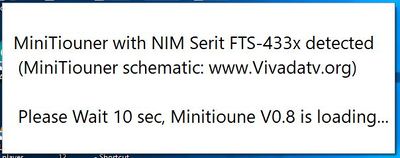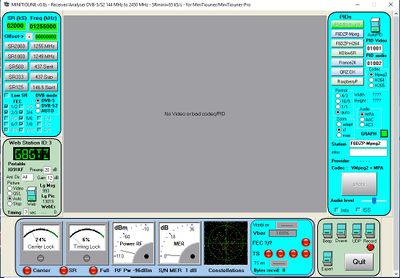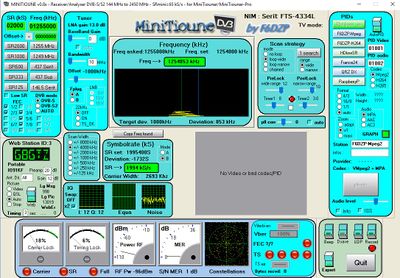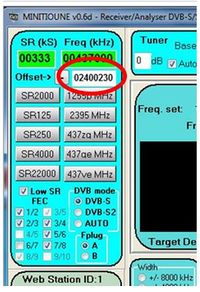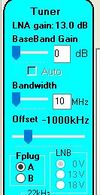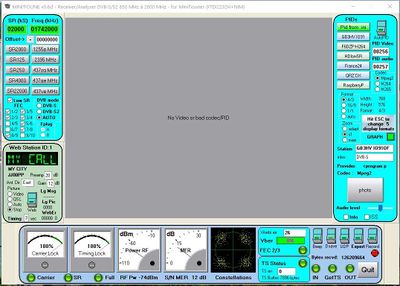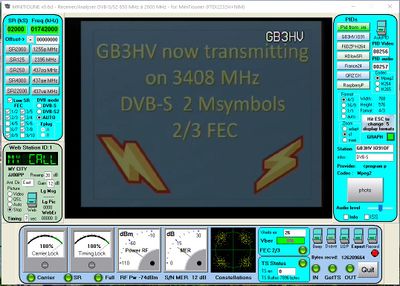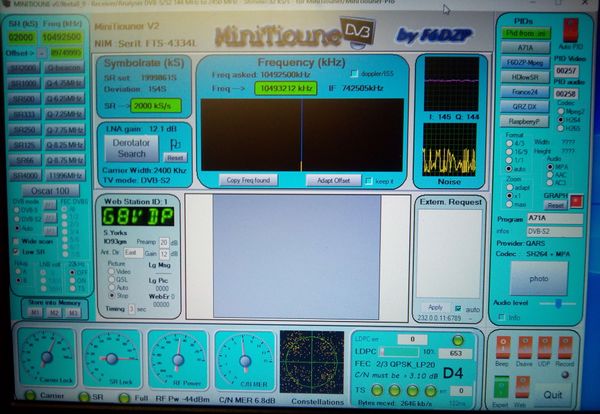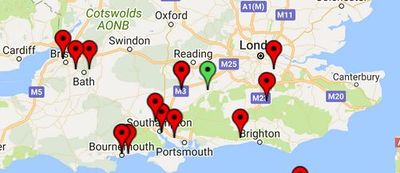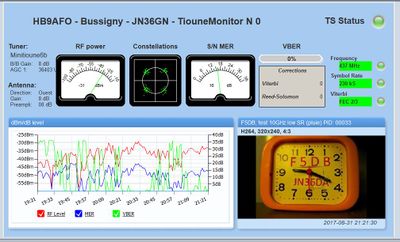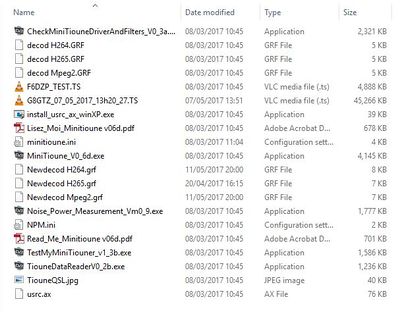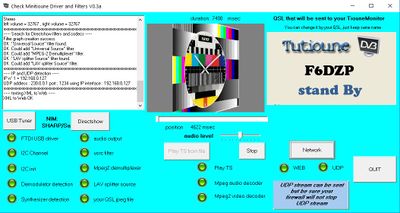Difference between revisions of "MiniTioune software"
| (28 intermediate revisions by the same user not shown) | |||
| Line 5: | Line 5: | ||
Once you have a log-in, V0.8 (latest version at Dec 2018) can be downloaded from here: http://www.vivadatv.org/viewtopic.php?f=60&t=521 | Once you have a log-in, V0.8 (latest version at Dec 2018) can be downloaded from here: http://www.vivadatv.org/viewtopic.php?f=60&t=521 | ||
| − | ===Version 0.8=== | + | ===Version 0.8 and later=== |
| − | You must do a small modification to the hardware to run Version 0.8 software before starting the program - see [[MiniTiouner_hardware_Version_2#MiniTiouner_version_0.8_software]] | + | You must do a small modification to the hardware to run Version 0.8 or later software before starting the program - see [[MiniTiouner_hardware_Version_2#MiniTiouner_version_0.8_software]] |
===Previous versions=== | ===Previous versions=== | ||
| Line 26: | Line 26: | ||
All test should pass - if it fails the USRC filter test try running the install_usrc_ax_winXP.exe file in the directory and run the test again. | All test should pass - if it fails the USRC filter test try running the install_usrc_ax_winXP.exe file in the directory and run the test again. | ||
| − | + | ==Running MiniTioune for the first time== | |
The Minitioune software is very comprehensive DVB-S receive and diagnostic software but can be a little overwhelming when you first run it! | The Minitioune software is very comprehensive DVB-S receive and diagnostic software but can be a little overwhelming when you first run it! | ||
| Line 81: | Line 81: | ||
| − | If this has happened but there is no video displayed in the center window, navigate to the top right of the screen and click the "Auto PID" button - the video should now appear! | + | If this has happened but there is no video displayed in the center window, navigate to the top right of the screen and click the "Auto PID" button which should be green - the video should now appear! |
[[File:tt5.JPG|400px]] | [[File:tt5.JPG|400px]] | ||
| − | + | ==Testing the MiniTioune using a FreeSat Satellite Signal== | |
If you do not have a local ATV signal to do initial tests with, you can use the signal from a Sky Satellite dish with a Universal LNB (frequencies will be different for a "Wideband" LNB) to test your MiniTioune as follows: | If you do not have a local ATV signal to do initial tests with, you can use the signal from a Sky Satellite dish with a Universal LNB (frequencies will be different for a "Wideband" LNB) to test your MiniTioune as follows: | ||
| Line 117: | Line 117: | ||
To receive the horizontal channels either supply 18v to the LNB supply via fuse 2 (be very careful not to short to 12v!) or simply turn the LNB on the dish through 90 degrees. | To receive the horizontal channels either supply 18v to the LNB supply via fuse 2 (be very careful not to short to 12v!) or simply turn the LNB on the dish through 90 degrees. | ||
| − | ===Other controls | + | ==Signals received but no video displayed== |
| + | |||
| + | MiniTiouner uses 2 seperate USB channels to communicate with the PC / LongMynd receiver. | ||
| + | |||
| + | *The first channel is used for control of the hardware and to display all the signal parameters on the PC screen. | ||
| + | *The second channel is used just to send the demodulated transport stream data from the hardware to the PC. This contains the video and audio packets plus the service information containing program name etc. | ||
| + | |||
| + | |||
| + | [[File:MT no video.jpg|600px]] | ||
| + | |||
| + | |||
| + | Very occasionally users have found that the software detects the MiniTiouner and displays all the signal parameters including green indicators but there is no video decode as shown in the above screen shot. | ||
| + | |||
| + | The very first thing to try is to navigate to the top right of the screen and click the "Auto PID" button which should be green and not red - the video should now appear. (Note prior to putting Auto PID on, there would be no program name shown in the white box or provider listed.) | ||
| + | |||
| + | If that does not fix it - read on... | ||
| + | |||
| + | The problem might just possibly be due to a tuner or USB module failure but we have had less than 10 hardware failures from 1,000 units sold, '''so it is almost certainly due to corruption of the software filters / decoders installed on the PC to display the video.''' | ||
| + | |||
| + | If the program and provider name is shown on the right hand side of the screen but no video appears, the hardware is 100% OK - in the above screen shot the program name A71AU and provider QARS is shown as this is the QO100 beacon. | ||
| + | |||
| + | The most common cause of this problem is corruption of the LAV filters and is resolved by running the install_usrc_ax_winXP.exe file in the MiniTiouner program directory. | ||
| + | |||
| + | If this does not solve the problem we recommend deleting the complete program directory (don't forget to save your .ini file if you have changed it) and then download version 0.8 http://www.vivadatv.org/viewtopic.php?f=60&t=521 | ||
| + | |||
| + | This is an older version but has the support files not present in the version 0.9 zip file http://www.vivadatv.org/viewtopic.php?f=60&t=625 | ||
| + | |||
| + | There should be a file "Read_Me_Minitioune v08s.pdf" that has the instructions. There are also test programs, Lav Filter installers etc. Run the CheckMiniTiouneDriverAndFilters_V0_5a.exe and address any problems it reports. | ||
| + | |||
| + | Once this is working, you should be able to run version 0.8. You can then download 0.9 from http://www.vivadatv.org/viewtopic.php?f=60&t=625 | ||
| + | |||
| + | If this does not cure the problem - ask for help on the BATC forum here https://forum.batc.org.uk/viewforum.php?f=105. | ||
| + | |||
| + | ==Other controls== | ||
[[File:v8 other.JPG|200px]] Set of soft controls located at the bottom right of the screen. | [[File:v8 other.JPG|200px]] Set of soft controls located at the bottom right of the screen. | ||
| Line 134: | Line 167: | ||
[[File:TT data.jpg|300px]] A typical display from the Data reader | [[File:TT data.jpg|300px]] A typical display from the Data reader | ||
| − | + | ==Customising MiniTioune with common settings== | |
You can edit the miniTioune.ini file in the download directory to configure various options to be set when you start the program including: | You can edit the miniTioune.ini file in the download directory to configure various options to be set when you start the program including: | ||
| Line 189: | Line 222: | ||
AddrUDP=127.0.0.1 | AddrUDP=127.0.0.1 | ||
Port=1234 | Port=1234 | ||
| + | |||
| + | Note in Version V0.9beta8 the following line needs to be removed or commented out | ||
| + | |||
| + | TS_AddrUDP=230.0.0.10 | ||
Now launch VLC, go to Media > open network stream and enter udp://@127.0.0.1:1234 in the network URL box and press play. | Now launch VLC, go to Media > open network stream and enter udp://@127.0.0.1:1234 in the network URL box and press play. | ||
Revision as of 16:05, 5 October 2019
The MiniTiouner USB receiver uses free to download DVB-S receive and analysis software called "Minitioune" written by F6DZP.
The Software, which will run on a PC with Windows 7, 8 or 10 operating system, is hosted on the VivaDATV forum. You need to register and be given a log-in to download the software. Please note MiniTuioune is not open source and will not run under Linux or MAC o/s.
Once you have a log-in, V0.8 (latest version at Dec 2018) can be downloaded from here: http://www.vivadatv.org/viewtopic.php?f=60&t=521
Version 0.8 and later
You must do a small modification to the hardware to run Version 0.8 or later software before starting the program - see MiniTiouner_hardware_Version_2#MiniTiouner_version_0.8_software
Previous versions
You will need Version v0.6 or newer if you have built a MiniTiouner Version 2 board with a Serit tuner (or a Serit tuner on a version 1 board with adapter card). Full installation procedure is at the bottom of this page.
Connecting the hardware
The MiniTiouner hardware is connected to the PC via USB2 mini cable.
It is absolutely essential you use a high quality USB cable or the program will frequently freeze and crash with no warning The recommended cable is a Lindy Cromo Lindy cable USB 2.0 type A/mini-B 1m long. https://www.lindy.co.uk/cables-adapters-c1/usb-c449/1m-cromo-usb-2-0-type-a-to-mini-b-cable-p6866
Running the test software
Connect up your MiniTiouner to the PC USB port and apply volts - then run the test programs found in the directory where you extracted MiniTiouner to.
All test should pass - if it fails the USRC filter test try running the install_usrc_ax_winXP.exe file in the directory and run the test again.
Running MiniTioune for the first time
The Minitioune software is very comprehensive DVB-S receive and diagnostic software but can be a little overwhelming when you first run it!
If you have completed the installation and tested your system by running the test programs, you now need to arrange a test signal which can be one of the following:
- A satellite signal from your domestic satellite dish.
- A local DATV signal from Portsdown (Ugly mode is fine) or any other DATV transmitter - a short piece of wire in the tuner input socket will probably pick up enough signal but be careful - there maybe DC volts on the socket.
- An off air DATV signal from your local repeater or "buddy down the road" (did I really write that!) - make sure you have a filter and line amplifier between your pre-amp and tuner input but be careful - there maybe DC volts on the input socket and most filters are DC short circuit.
Whichever source you use, you will need to know the following:
- Signal frequency - you will need to know L band signal frequency coming out of the LNB or direct amatuer band frequency - eg 1255MHz or 1563 MHz
- DVB mode - DVB-S or DVB-S2
- The Symbol Rate or SR - this will probably be listed as MegaSymbols - eg 2Ms or 27Ms - you will need to convert this to kS - eg 2000 or 27000
- The FEC rate - this will be written in the form 1/2 or 5/6
Start the program and you should see the please wait message. If you get the USB error message then you hardware is not connected.
and then the following screen:
If you see the more complex expert mode below - simply click the top of the "expert" switch in the bottom right hand corner of the screen.
Navigate your mouse to the top left corner of the screen and set the following parameters to match your test signal:
- Symbol rate (SR) - type the symbol rate directly in to the top left green box. (Note this should be the SR in kilosymbols in the following form - 00250 for 250kS, 02000 for 2Ms,or 27000 for 27Ms.
- FEC - tick the box to match the FEC of the transmission you are wanting to rx.
- DVB mode - tick the correct mode box. Currently all DATV signals are currently DVB-S and most domestic satellite signals are DVB-S2. For ATV operation make sure the DVB-S box is ticked and not auto.
- Low SR - if you are trying to receive a signal greater than 1Msymbol or 1000ksymbol untick the low SR box.
- Frequency - type directly in to the top right green box. (Note this should be the L band frequency in the following form - 01255000 for 1255MHz. if it is not the correct format the box will be greyed out).
If you are using a Serit tuner, which covers 144 - 2550 MHz without any upconverters, make sure you have NO offset in the white box under the frequency box. If there is a a number present simply enter "00000000" to overwrite it. If you are using a Sharp tuner with an upconverter you will need to enter the L band frequency in the green box or the receive frequency in the green box plus LO offset in the white box.
If using a Serit tuner, select the A or B f type connector using the A or B button. (note the A socket is the one furthest away from the PCB on the tuner can).
The 3 "lights" at the bottom left of the screen should now turn green, the meters should indicate signal level and MER, you should see dots in the 4 quadrants of the constellation window and the Viterbi error bar graph should go green.
If this has happened but there is no video displayed in the center window, navigate to the top right of the screen and click the "Auto PID" button which should be green - the video should now appear!
Testing the MiniTioune using a FreeSat Satellite Signal
If you do not have a local ATV signal to do initial tests with, you can use the signal from a Sky Satellite dish with a Universal LNB (frequencies will be different for a "Wideband" LNB) to test your MiniTioune as follows:
- Place a jumper on J3, which is near the 12v power socket. Check that there is now 12v on the upper NIM F socket.
- Connect the upper NIM socket to a Sky dish.
- Start the MiniTioune software.
- In the frequency setting area in the top left of the screen, put 09750000 into the OFFSET box.
- Click the PLUS / MINUS indicator next to it so that it shows MINUS.
- Put 10758000 into the FREQ box.
- Put 22000 into the SR box.
Further down from the FREQ box, below the frequency buttons, check that DVB-S and Fplug-A are selected and that there is a tick in the checkbox next to 5/6 FEC.
You should now see the ITV program in the video window.
There are several channels on each Sky transponder and these should appear on the buttons at the top right of the screen, below PIDs. A 12v supply will select vertical transponders. Use 12v rather than 13.8v, to stay below the switching threshold for horizontal transponders.
Other transponder frequencies can be found at https://www.lyngsat.com/Astra-2E-2F-2G.html The symbol rate (SR) and DVB-S / DVB-S2 setting may need to be changed for other transponders.
Note the MiniTiouner hardware does not generate 22KHz and will not switch in the High LO in an LNB. However, as the tuning range of the MiniTiouner with a Serit tuner goes up to 2450MHz it is possible to receive the higher channels by using the 9750 offset described above. Simply take 9750 off the channel frequency and enter the result in to the frequency box.
To receive the horizontal channels either supply 18v to the LNB supply via fuse 2 (be very careful not to short to 12v!) or simply turn the LNB on the dish through 90 degrees.
Signals received but no video displayed
MiniTiouner uses 2 seperate USB channels to communicate with the PC / LongMynd receiver.
- The first channel is used for control of the hardware and to display all the signal parameters on the PC screen.
- The second channel is used just to send the demodulated transport stream data from the hardware to the PC. This contains the video and audio packets plus the service information containing program name etc.
Very occasionally users have found that the software detects the MiniTiouner and displays all the signal parameters including green indicators but there is no video decode as shown in the above screen shot.
The very first thing to try is to navigate to the top right of the screen and click the "Auto PID" button which should be green and not red - the video should now appear. (Note prior to putting Auto PID on, there would be no program name shown in the white box or provider listed.)
If that does not fix it - read on...
The problem might just possibly be due to a tuner or USB module failure but we have had less than 10 hardware failures from 1,000 units sold, so it is almost certainly due to corruption of the software filters / decoders installed on the PC to display the video.
If the program and provider name is shown on the right hand side of the screen but no video appears, the hardware is 100% OK - in the above screen shot the program name A71AU and provider QARS is shown as this is the QO100 beacon.
The most common cause of this problem is corruption of the LAV filters and is resolved by running the install_usrc_ax_winXP.exe file in the MiniTiouner program directory.
If this does not solve the problem we recommend deleting the complete program directory (don't forget to save your .ini file if you have changed it) and then download version 0.8 http://www.vivadatv.org/viewtopic.php?f=60&t=521
This is an older version but has the support files not present in the version 0.9 zip file http://www.vivadatv.org/viewtopic.php?f=60&t=625
There should be a file "Read_Me_Minitioune v08s.pdf" that has the instructions. There are also test programs, Lav Filter installers etc. Run the CheckMiniTiouneDriverAndFilters_V0_5a.exe and address any problems it reports.
Once this is working, you should be able to run version 0.8. You can then download 0.9 from http://www.vivadatv.org/viewtopic.php?f=60&t=625
If this does not cure the problem - ask for help on the BATC forum here https://forum.batc.org.uk/viewforum.php?f=105.
Other controls
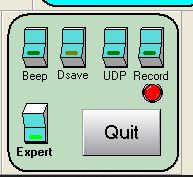
The "Record" button records the received transport stream as a .ts file in to the folder where minitioune.exe was installed. .ts files can be replayed with WMP or VLC.
The "Bleep" button enables an audio tone which varies in pitch depending upon the strength of the signal being received. Useful for peaking up aerials or adjusting filters and pre-amps.
The "UDP" button enables the received transport stream to be played out in real time over UDP, enabling it to be played on a remote PC using VLC.
The "Expert" button reveals a whole host of additional controls described below.
The "Dsave" button records a number of parameters about the received signal, such as strength MER and TS Lock as a .txt file. These can replayed in the TiouneDataReader.exe program to give a graphical display of the received signal. This is useful for later analysis when receiving signals such as the ISS HAMTV transmissions.
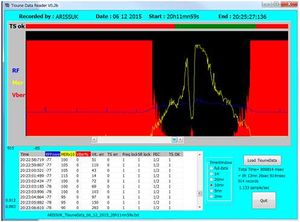 A typical display from the Data reader
A typical display from the Data reader
Customising MiniTioune with common settings
You can edit the miniTioune.ini file in the download directory to configure various options to be set when you start the program including:
- The preset buttons for Frequency (with LNB / converter offsets), symbol rates and PID (see below)
- FEC selected on startup
- DVB mode on start up
- DC volts on tuner output
- Your call sign and station details for the web monitoring facility (see below)
- Expert screen off for start up
To edit the file, first save a copy of the file on to your desktop - this is so you can always go back when you mess up (and you almost certainly will)! Then double click the file and it should open in wordpad.
Web monitor
One really useful feature of MiniTioune is the ability for remote stations to monitor how well you are receiving their signal. To enable this you need an account on VivaDATV where you downloaded the software from.
Then you need to edit the miniTioune.ini file as described above.
Go to the [WebMonitoring] section and put your call sign where it says OM_ID=MY CALL, enter your vivadatv password forum and your QRA.
Save the file and restart MiniTiouner.
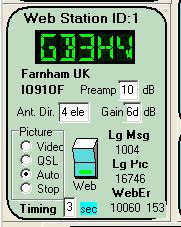
Now go to http://www.vivadatv.org/tutioune.php?what=map and zoom in on your location - you will see that stations who have their web monitor turned on are shown in green.
Stations who are actively receiving a signal are shown as bouncing green pins - click on the pin and you can details of the signal being received, including MER, RF Level, FEC, bit rate and a thumbnail updated every second.
Using MiniTioune with VLC
You may find that some stations seem to have jerky video or poor intermittent sound and can be decoded more reliably with the open source VLC player.
This is because MiniTioune uses the standard Windows demultiplexer to decode the audio and video and this is very critical on timing of the incoming signal.
If the incoming signal is not strictly DVB compliant and has PCR or PTS errors (the PCR timing must be less than 500 nano seconds) the Window demultiplexer will not decode it properly and it has been found that VLC is more tolerant to errors.
- To use VLC player on the same PC, edit the MiniTioune .ini file (found in the same directory as the MiniTioune program) as follows:
;===================================================================== ; adresse UDP / UDP address [UDP] ;===================================================================== AddrUDP=127.0.0.1 Port=1234
Note in Version V0.9beta8 the following line needs to be removed or commented out
TS_AddrUDP=230.0.0.10
Now launch VLC, go to Media > open network stream and enter udp://@127.0.0.1:1234 in the network URL box and press play.
- To use VLC and a seperate device (PC, Media player, Raspbery PI etc) put the IP address of the player device in the MiniTiouner .ini file and then put udp://@:1234 in the VLC network address on the remote device.
Expert Mode
To be completed.....
Ken W6HHC has a written a very comprehensive user guide for MiniTiouner-Express system which uses the same software as the BATC hardware - this is available here https://www.datv-express.com/uploads/UserGuide/MiniTouner-Express%20User-Guide-draft15.pdf
Software Installation V7 and before only
Download the zip file and extract to a folder under your root or c:\ directory. You should have the following files (except the G8GTZ video file!) in your directory:
There is a readme file contained in the download which you should read.
Once you have unzipped the main download you need to follow these easy steps to get up and running:
- Download and install the D2XX drivers 2.12.24 found at http://ftdichip.com/Drivers/D2XX.htm. There's a link in the right column for a setup executable.
- Download and install LAVfilters CODECs from here http://www.videohelp.com/software/LAV-Filters
- Look in the Minitiouner folder that you've just copied to C:\ for the small program "Install_usrc_ax_winXP" and run this to install the link with the decoder.
- Plug in your MiniTiouner hardware and let the USB drivers install.
- Run the MiniTiouner test program - "CheckMiniTiouneDriverAndFilters_V0_3a.exe" - it should pass on all sections.
For a very comprehensive guide on the software installation, see the user guide written by W6HHC - http://www.w6ze.org/DATV/InstallingMiniTiouner_onWin10.pdf
